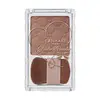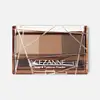What's inside
What's inside
 Key Ingredients
Key Ingredients

 Benefits
Benefits

 Concerns
Concerns

 Ingredients Side-by-side
Ingredients Side-by-side

Talc
AbrasiveSynthetic Fluorphlogopite
Squalane
EmollientNylon-12
Silica
AbrasiveDimethicone
EmollientDiisostearyl Malate
EmollientPhytosteryl/Isostearyl/Cetyl/Stearyl/Behenyl Dimer Dilinoleate
Skin ConditioningPhytosteryl/Octyldodecyl Lauroyl Glutamate
Skin ConditioningDipentaerythrityl Hexahydroxystearate/Hexastearate/Hexarosinate
Skin ConditioningMethicone
EmollientPerfluorooctyl Triethoxysilane
Aluminum Hydroxide
EmollientHydrogen Dimethicone
Tocopherol
AntioxidantButylparaben
MaskingMethylparaben
PreservativeWater
Skin ConditioningButylene Glycol
HumectantPueraria Lobata Root Extract
HumectantCitrus Limon Fruit Extract
MaskingEquisetum Arvense Extract
AstringentHumulus Lupulus Extract
AntimicrobialPinus Sylvestris Cone Extract
MaskingRosmarinus Officinalis Extract
AntimicrobialAloe Barbadensis Leaf Extract
EmollientChlorella Vulgaris Extract
Skin ConditioningIron Oxides
Mica
Cosmetic ColorantCI 77891
Cosmetic ColorantCI 77007
Cosmetic ColorantTalc, Synthetic Fluorphlogopite, Squalane, Nylon-12, Silica, Dimethicone, Diisostearyl Malate, Phytosteryl/Isostearyl/Cetyl/Stearyl/Behenyl Dimer Dilinoleate, Phytosteryl/Octyldodecyl Lauroyl Glutamate, Dipentaerythrityl Hexahydroxystearate/Hexastearate/Hexarosinate, Methicone, Perfluorooctyl Triethoxysilane, Aluminum Hydroxide, Hydrogen Dimethicone, Tocopherol, Butylparaben, Methylparaben, Water, Butylene Glycol, Pueraria Lobata Root Extract, Citrus Limon Fruit Extract, Equisetum Arvense Extract, Humulus Lupulus Extract, Pinus Sylvestris Cone Extract, Rosmarinus Officinalis Extract, Aloe Barbadensis Leaf Extract, Chlorella Vulgaris Extract, Iron Oxides, Mica, CI 77891, CI 77007
Diisostearyl Malate
EmollientTriethylhexanoin
MaskingZinc Myristate
Hdi/Trimethylol Hexyllactone Crosspolymer
Dimethicone
EmollientPentylene Glycol
Skin ConditioningPhenoxyethanol
PreservativeSilica
AbrasiveMethylparaben
PreservativeTocopherol
AntioxidantWater
Skin ConditioningButylene Glycol
HumectantHydroxyapatite
AbrasiveCyclopentasiloxane
EmollientZinc Oxide
Cosmetic ColorantTrimethylsiloxysilicate
EmollientAlcohol Denat.
AntimicrobialSodium Lauroyl Glutamate
Palmaria Palmata Extract
Skin ProtectingPanax Ginseng Root Extract
EmollientPolyquaternium-61
Skin ConditioningHydrolyzed Collagen
EmollientCysteine/Oligomeric Proanthocyanidin
Skin ConditioningPvp
Emulsion StabilisingHydroxyethylcellulose
Emulsion StabilisingAlgin
MaskingCitrus Junos Fruit Extract
Skin ConditioningChitosan
Cetearyl Glucoside
EmulsifyingSodium Polyglutamate
HumectantSodium Hyaluronate
HumectantTalc
AbrasiveMica
Cosmetic ColorantCI 77492
Cosmetic ColorantTitanium Dioxide
Cosmetic ColorantDiisostearyl Malate, Triethylhexanoin, Zinc Myristate, Hdi/Trimethylol Hexyllactone Crosspolymer, Dimethicone, Pentylene Glycol, Phenoxyethanol, Silica, Methylparaben, Tocopherol, Water, Butylene Glycol, Hydroxyapatite, Cyclopentasiloxane, Zinc Oxide, Trimethylsiloxysilicate, Alcohol Denat., Sodium Lauroyl Glutamate, Palmaria Palmata Extract, Panax Ginseng Root Extract, Polyquaternium-61, Hydrolyzed Collagen, Cysteine/Oligomeric Proanthocyanidin, Pvp, Hydroxyethylcellulose, Algin, Citrus Junos Fruit Extract, Chitosan, Cetearyl Glucoside, Sodium Polyglutamate, Sodium Hyaluronate, Talc, Mica, CI 77492, Titanium Dioxide
Ingredients Explained
These ingredients are found in both products.
Ingredients higher up in an ingredient list are typically present in a larger amount.
Butylene Glycol (or BG) is used within cosmetic products for a few different reasons:
Overall, Butylene Glycol is a safe and well-rounded ingredient that works well with other ingredients.
Though this ingredient works well with most skin types, some people with sensitive skin may experience a reaction such as allergic rashes, closed comedones, or itchiness.
Learn more about Butylene GlycolDiisostearyl Malate is an emollient and most often used in lip products. It comes from isostearyl alcohol, a fatty acid, and malic acid, an AHA.
As an emollient, Diisostearyl Malate helps create a thin film on your skin to trap moisture in. This helps keep your skin soft and smooth.
Dimethicone is a type of synthetic silicone created from natural materials such as quartz.
What it does:
Dimethicone comes in different viscosities:
Depending on the viscosity, dimethicone has different properties.
Ingredients lists don't always show which type is used, so we recommend reaching out to the brand if you have questions about the viscosity.
This ingredient is unlikely to cause irritation because it does not get absorbed into skin. However, people with silicone allergies should be careful about using this ingredient.
Note: Dimethicone may contribute to pilling. This is because it is not oil or water soluble, so pilling may occur when layered with products. When mixed with heavy oils in a formula, the outcome is also quite greasy.
Learn more about DimethiconeMethylparaben is a preservative and is a paraben. It is used to prevent the growth of fungus, mold, and other harmful bacteria. Parabens are chemicals used as preservatives in both cosmetics and food.
Methylparaben can be synthetically created. It can also be found naturally in some fruits, such as blueberries.
Oftentimes, Methylparaben is combined with other parabens to help increase the shelf life.
The safety of Methylparaben is currently being studied. While ongoing studies are looking into the safety of parabens, the results have been very mixed. Some studies have not found Methylparaben to be harmful.
Learn more about MethylparabenMica is a naturally occurring mineral used to add shimmer and color in cosmetics. It can also help improve the texture of a product or give it an opaque, white/silver color.
Serecite is the name for very fine but ragged grains of mica.
This ingredient is often coated with metal oxides like titanium dioxide. Trace amounts of heavy metals may be found in mica, but these metals are not harmful in our personal products.
Mica has been used since prehistoric times throughout the world. Ancient Egyptian, Indian, Greek, Roman, Aztec, and Chinese civilizations have used mica.
Learn more about MicaSilica, also known as silicon dioxide, is a naturally occurring mineral. It is used as a fine, spherical, and porous powder in cosmetics.
Though it has exfoliant properties, the function of silica varies depending on the product.
The unique structure of silica enhances the spreadability and adds smoothness, making it a great texture enhancer.
It is also used as an active carrier, emulsifier, and mattifier due to its ability to absorb excess oil.
In some products, tiny microneedles called spicules are made from silica or hydrolyzed sponge. When you rub them in, they lightly polish away dead skin layers and enhance the penetration of active ingredients.
Learn more about SilicaTalc is a clay mineral. It helps absorb moisture and improve the texture of products. Like other types of clay, Talc can have a slight exfoliating effect on skin. Talc can be added to increase the volume of products.
Some Baby powders are made by combining talc with corn starch. The word "talc" comes from Latin and originates from Arabic. Talc is a mineral commonly found throughout the world.
If you have any concerns about using talc, we recommend checking out the FDA's official page.
Learn more about TalcTocopherol (also known as Vitamin E) is a common antioxidant used to help protect the skin from free-radicals and strengthen the skin barrier. It's also fat soluble - this means our skin is great at absorbing it.
Vitamin E also helps keep your natural skin lipids healthy. Your lipid skin barrier naturally consists of lipids, ceramides, and fatty acids. Vitamin E offers extra protection for your skin’s lipid barrier, keeping your skin healthy and nourished.
Another benefit is a bit of UV protection. Vitamin E helps reduce the damage caused by UVB rays. (It should not replace your sunscreen). Combining it with Vitamin C can decrease sunburned cells and hyperpigmentation after UV exposure.
You might have noticed Vitamin E + C often paired together. This is because it is great at stabilizing Vitamin C. Using the two together helps increase the effectiveness of both ingredients.
There are often claims that Vitamin E can reduce/prevent scarring, but these claims haven't been confirmed by scientific research.
Learn more about TocopherolWater. It's the most common cosmetic ingredient of all. You'll usually see it at the top of ingredient lists, meaning that it makes up the largest part of the product.
So why is it so popular? Water most often acts as a solvent - this means that it helps dissolve other ingredients into the formulation.
You'll also recognize water as that liquid we all need to stay alive. If you see this, drink a glass of water. Stay hydrated!
Learn more about Water